With fashion as his tool, young designer Jessan Macatangay is empowering women to break free and embrace sensuality
Related: How Young Designer Jessan Macatangay Found Beauty And Powe r Amidst The Pandemic
When you’re raised in a culture of religiosity and conservative ideals, there’s a certain limit up to which you can freely express yourself, particularly through your craft. But UK-based Filipino designer Jessan Macatangay knew all too well that it was time to flourish beyond traditions, and embrace a bolder, freer way of asserting one’s individuality.
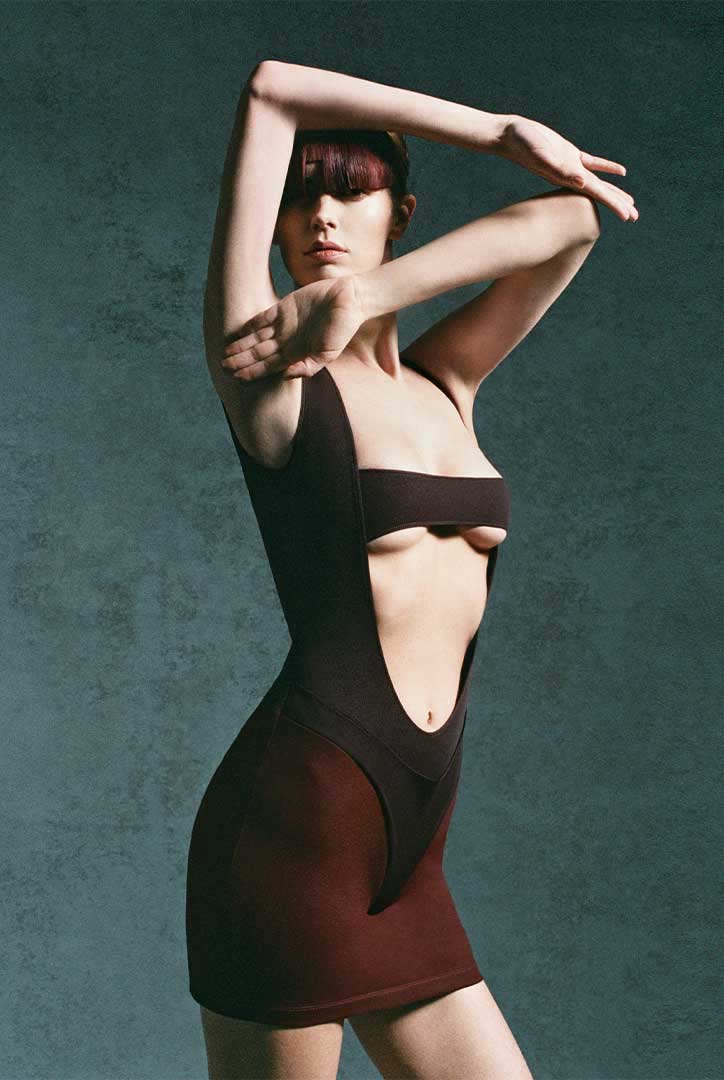
Before becoming the acclaimed artist that he is today, Macatangay was a licensed nurse in the Philippines. He had no idea what he wanted to do after graduating from high school since he liked a lot of things, but couldn’t figure out exactly what to pursue. The idea of taking up nursing was suggested by his mother—but his heart really wasn’t in the practice.
After he got his Professional Regulation Commission (PRC) license, the young designer started attending pattern-cutting short courses in Manila. The more he looked into the possibility of pursuing a career in fashion, the more he couldn’t stay off this track. Naturally, he learned about Central Saint Martins (CSM) in London, where he is now currently based. Eventually, he finished his Bachelor’s of Arts (BA) Degree in Fashion Design at CSM, and later took his Master of Arts in Fashion Womenswear, which he had just finished.
“For this last collection, my original research and inspiration was derived from the women I grew up with: my mom, sister and other family members,” Macatangay shares. “Their fashion sense was constrained due to the Catholic culture in the Philippines. I always felt that they couldn’t express themselves the way they wanted because showing skin was considered risqué and frowned upon. It was like an unwritten rule that everyone knew and was stigmatized.”
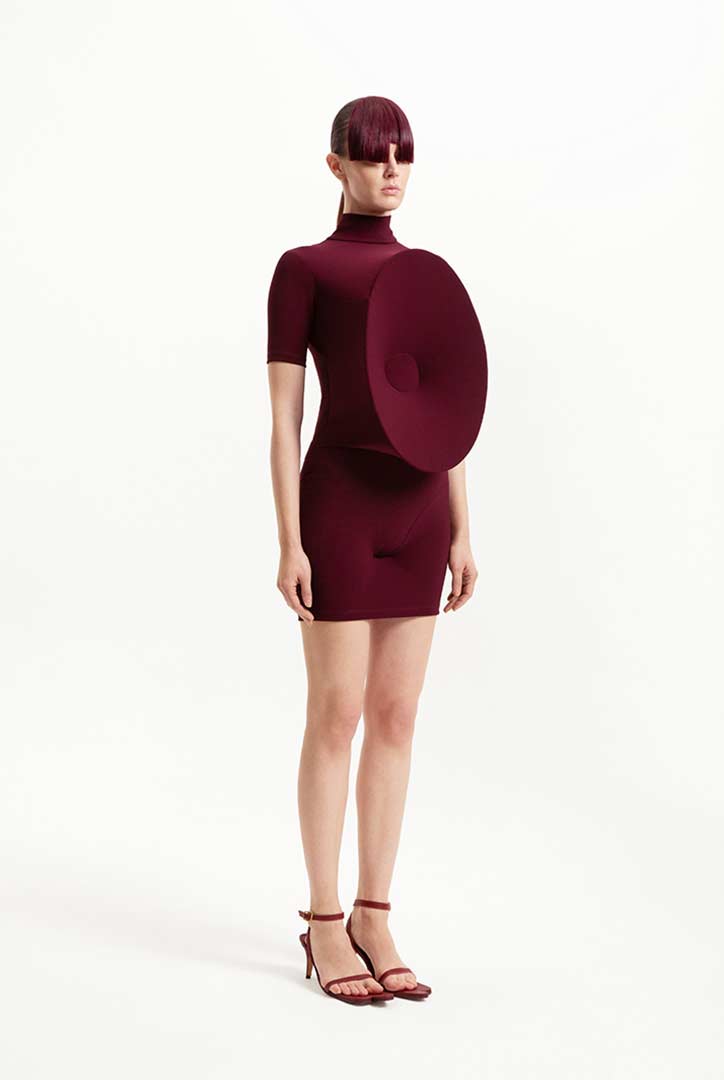
Ultimately, what he wants his collections and work in general to do is to give women empowerment and a chance to express themselves as they want to: “I want my collection to give them the spark of excitement of wearing whatever they want, even if it shows a lot of skin. Fundamentally, I want to dress for women who want to feel sensual and sexy and are unafraid to show skin. It should be their choice, not someone else’s choice imposed on them.”
BARE AND BOLD
Macatangay undoubtedly has a unique and interesting take on design. His tasteful play with structures, materials, and fashion principles create pieces that are unlike any other.
“My whole process changed over time, especially while studying for my masters,” says Macatangay. “Previously, I always started my process with something abstract or conceptual. Right now, the starting point is always her, the woman, my muse—who she is and everything about her. My initial research must have something to do about her, whether it’s something conceptual or some piece of clothing.”
Far from traditional concepts, his work is mostly in 3D because it’s what he loves to do the most. From an abstract notion, he selects parts of his research that are visually appealing to him, picking up things that can be translated in a tangible way. Using a mannequin, he starts working on it—like an actual body—while following the concept of the collection.
There’s something about the creative process of making, building, and developing art that draws Macatangay so deeply. He focuses on a lot of drapings, fittings, and pattern cutting. This is the part of the design process he loves the most and where he spends most of his time refining. From these, the final looks are selected.
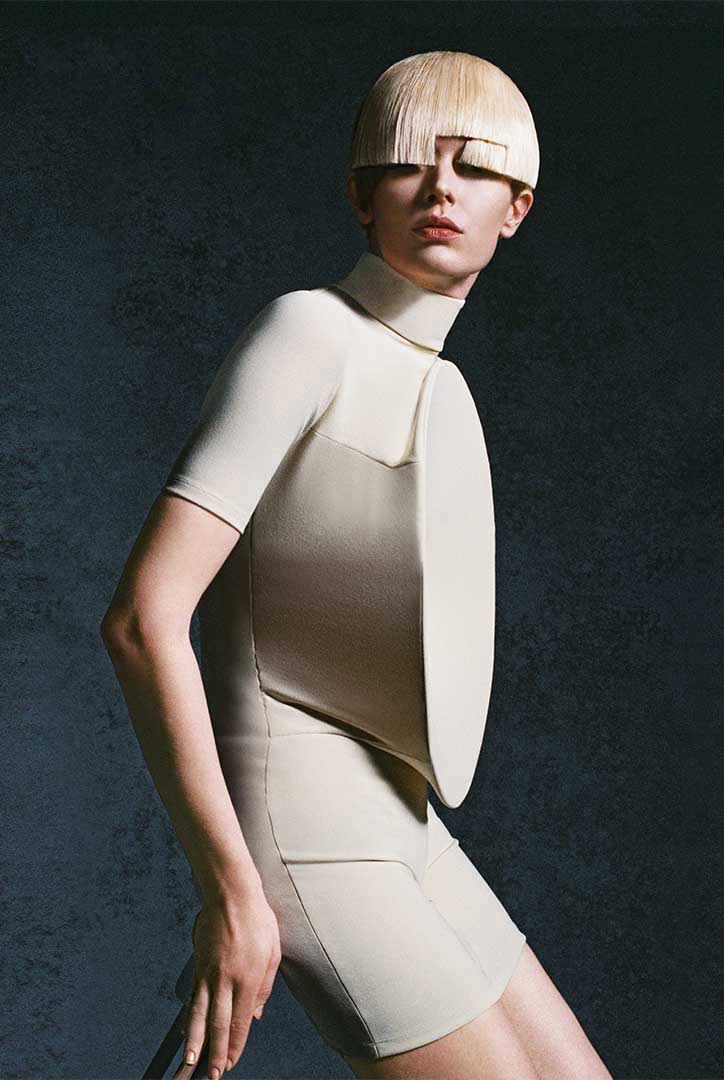
His collection “Sculptural Sensuality” possesses a theme that explores sensuality using restrictive formed objects. This recent line started with the idea of Filipino women’s discomfort of showing skin.
“In our country, 85 percent of the population is Roman Catholic,” he explains. “Even in 2022, despite having improved, we are still very modest, especially in the province where religion and culture still impose restraints on women particularly on how they dress. I grew up in the Batangas seeing the women around me dressed in a certain way, which was always modest and a bit conservative because we were religious.”
He adds, “In the province, even until now, if you wear a skirt that is too short, people will have a strong reaction towards you. If you show cleavage, people will still raise their eyebrows. Our country is surrounded by water. Even when you wear a swimsuit at the beach, some women still have this fear of being judged by other people for showing skin. Even current local personalities, those who constantly post bikini photos and show lots of skin, are being judged and bashed to cover up, sometimes by other women.”
Here’s a typical situation: seeing women put t-shirts over their bikinis while swimming just to cover up. In local Catholic churches in the south where he came from, he retells conservative rules such as when a woman gets married, the neckline should not be low and that there needs to be fabric covering the bride’s whole shoulder and chest.
His project started with this fear and discomfort of showing skin, which led him to look into ’90s swimwear advertisements that gave birth to the kind of clothing that shows and bares skin. From this, he became intrigued by the history of swimwear design for men and women, and started looking at much earlier styles that date back to the 1910s—cut-outs prevailing. Aside from this, he also found himself intrigued and inspired by Robert Mapplethorpe’s sculpture “Layers of Underwear,” where soft fabrics are stretched and imposed onto hardware.
“I merged the principles of sensuality and softness with restrictive, harsh, and contrasting materials, almost subconsciously creating a metaphor for the Filipino woman. The hardwire used to create structured forms symbolizes the restrictiveness of the Catholic church. Three-dimensional layers provide depth while the imposed feminine form gives birth to unexpected tensions, textures, and shapes. Sculptural forms sprout from contrasting layers of crepe jersey stretched by wired frames, existing to mimic a swimsuit’s outline, acting as a surrealist manipulation and extension of the body. Most of the frames are shaped into a woman’s body to highlight its shape,” Macatangay explains.
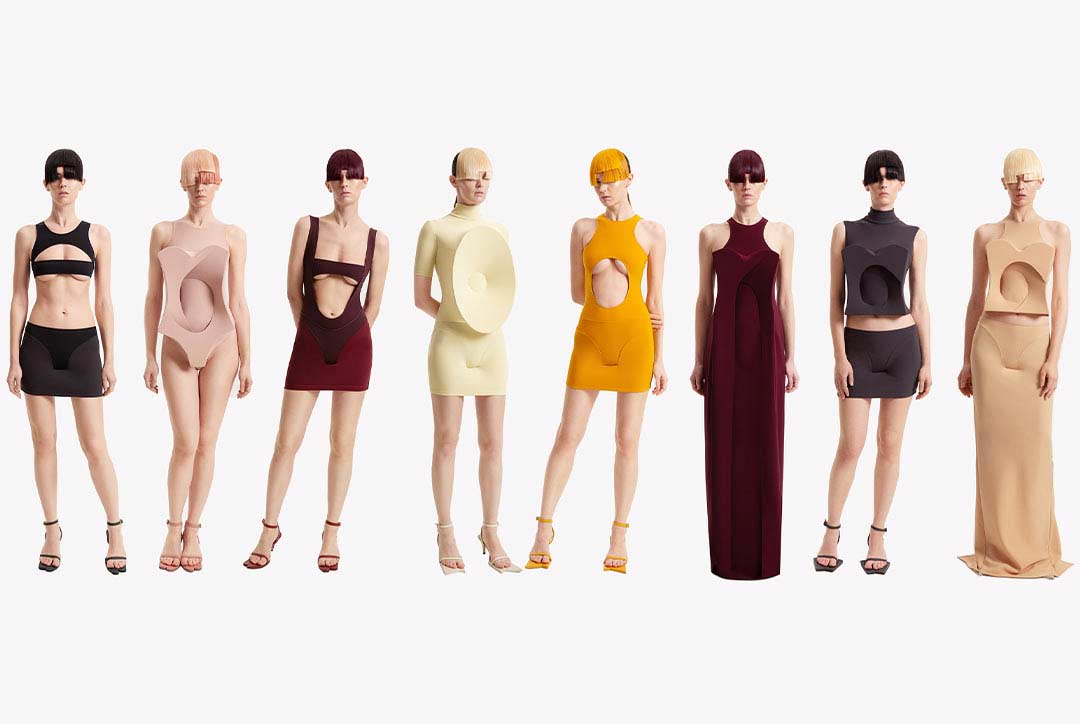
One of his favorite aspects of the collection are the skirts which he called “knicker skirts.” This is literally a panty and skirt at the same time, with the whole collection being made from jersey. After experimenting with quite a few samples, he found luxurious-looking cotton jerseys and decided to use them together with the usual jersey fabrics.
There is as much attention to detail as there is immense gravity on the narrative of his work. It all goes back to his ultimate subject: the woman.
“This collection is about making society realize that a woman is more than her body. Clothes exist to accentuate the feminine figure and showcase it in its most lustrous light. I really want these pieces for women who adore sensuality without fearing sexuality; and for the women who long to relax on a beach with their swimsuit, legs and arms sun-kissed and basking in light. She does not want to cover up with a t-shirt on the beach. She wants to be free of restrictions and imposed judgements,” he says.
AN ODE TO THE MUSE
One of the hardest things Macatangay had to face was finding what his work stands for. Some people might say it should be easy, but being pretentious when it comes to things, especially his work, is not on his list. For him, it must be personal and something he really believes in. What has he learned so far in his fashion journey? Make sure your work makes sense.
“It’s quite tricky when you’re still exploring, but once you figure it out, you will become a more mature designer. I think one of the best moments of my whole fashion journey was discovering who is the woman I want my work to represent. I think this was one of my best takeaways from seven years of working in fashion. It wasn’t easy at the beginning, because I’m a designer who always wants to do crazy stuff—which I still love. But during the process of doing this collection, I would always ask: Does it make sense? Who is it for? Why? After figuring out who she is, it all made sense. I can still be creative as much as I want but it should be about her, and it should make sense for who she is,” Macatangay shares.
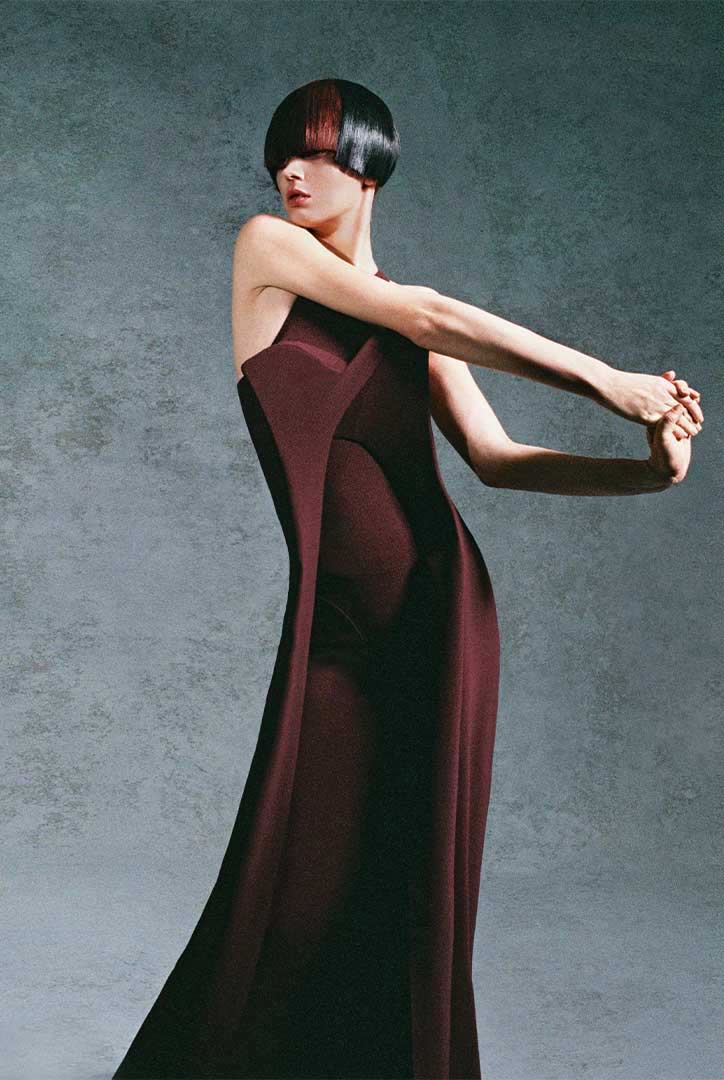
The lesson he can share to young designers who are starting their career in fashion is to always follow one’s gut and consistently find a challenge to learn from. At the heart of it all, it matters to always remember why one started doing fashion. Also, comparing with other designers isn’t something to indulge in. This is tricky and very complicated, especially in the early part of an artist’s career, but this never helped anyone.
BEAUTY IN STRUGGLE
The collection that is closest to Macatangay’s heart is his Fall 2020 collection, which was his graduation collection at Saint Martins. It’s mainly because it was completely done during the first ever lockdown of the pandemic. It was the scariest and, at the same time, the most rewarding process he did.
During his bachelor’s degree, every student had this vision of doing their final collection and having a fashion runway after four long years of studying. But in March 2020, they announced the first lockdown due to the pandemic—his whole experience of doing his final collection flipped from what he envisioned it to be. Because of this, there were a lot of things that he had to change in terms of design, materials, and process.
His challenge in production was mainly the resources and facilities that were supposed to fabricate some of his pieces. Because of the lockdown, the fabric supplier that he was specifically working with abruptly closed; thus, this forced him to find other options, which included dyeing most of his fabrics and digitally printing some.
Aside from using fabrics, Macatangay also used a lot of materials like wood and metal, for which he depended on the school’s facilities to produce. But because the university closed, he had no access to these wood and metal workshops to make his final pieces. Despite having to make do with scraps and available chairs and materials he had at home, putting them together manually, using simple tools he bought online, Macatangay enjoyed this project. The process of achieving and making these changes made him realize that this situation completely reflected the concept of his BA graduation collection—finding beauty and power in struggle.
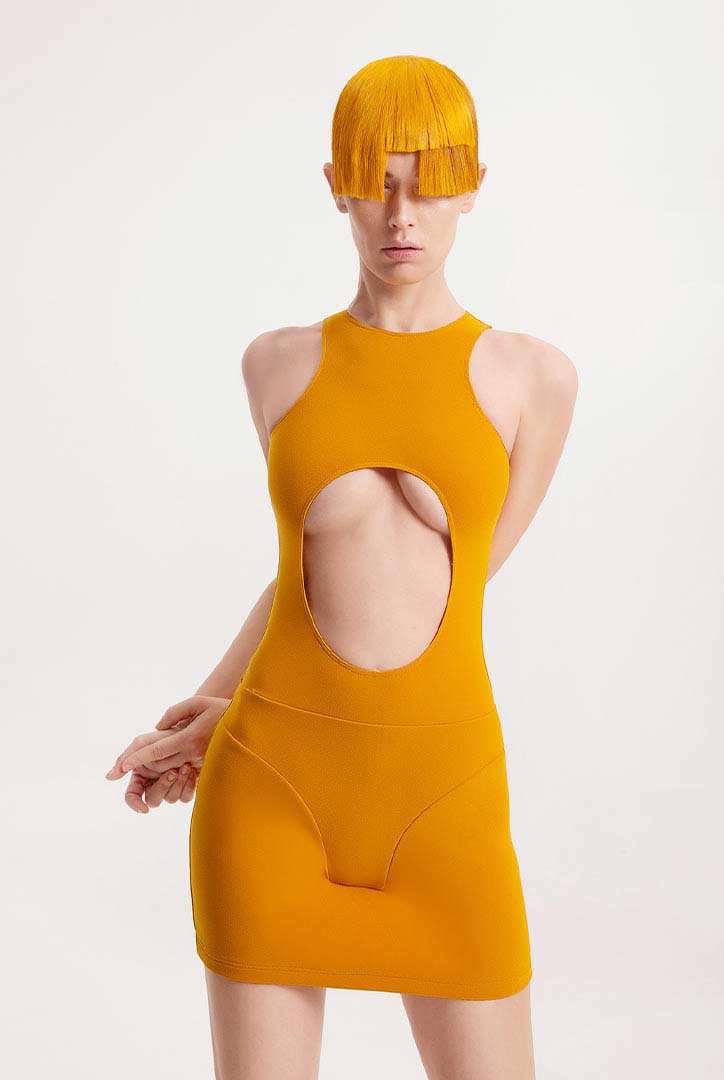
“As I dealt with my disappointment about the whole situation and not having a runway show to culminate it, I found myself reinspired, more resilient, and unwilling to give up. I felt empowered seeing my final garments come together under these circumstances. When it comes to presentation, initially my collection was always about the physical: better that you see and touch it physically,” Macatangay explains, noting that when he was working on this project pre-lockdown, his thoughts were centered on the runway and thus made some design decisions based on how people would see it in a physical showcase.
However, with the challenge, it became imperative to present his work digitally (which he discovered that he loved to do). There was a complete change to his thinking. It became more strongly about how people would consume his work, and less about the moment the runway represents. He could still show movement, but he had the opportunity to maximize focus on the many details that comprise his looks.
After finishing the whole collection, he was simply happy and proud of the fact he persevered. Even now, the way he works and deals with his process is based on the lessons he learned from the Fall 2020 collection.
AN AUTHENTIC FASHION
“I think the closer the designer is to the customer, the deeper the understanding of the client and their cultural environment,” says Macatangay “The edge of a local designer is we can take advantage of things that are not known in the mainstream, which will resonate in our designs. For me, I thought of designing international fashion with an influence from my awareness of the cultural restrictions women in the Philippines face.”
With a goal to further develop his work which shall eventually lead to having his own brand, Macatangay talked to a lot of his friends who graduated from the same course and went on the same journey as he did. He felt that there are still a lot of things to work on before setting up his own business, so he’s taking his time to prepare for it.
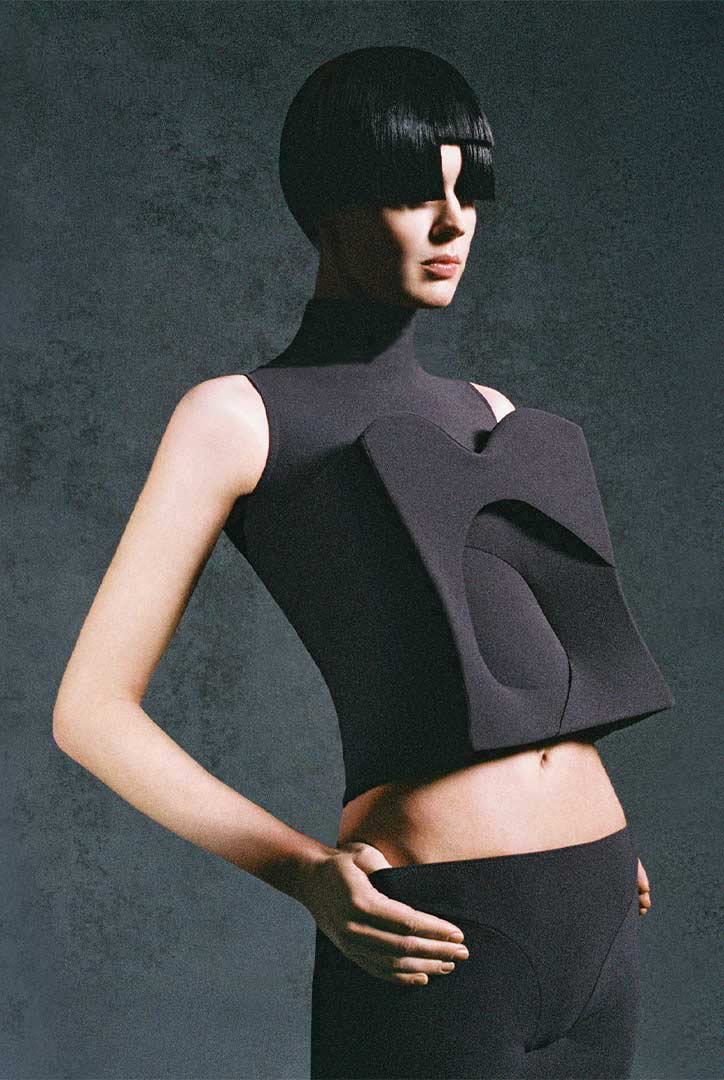
Although nothing else amazes Macatangay better than seeing his garments on models on the runway, he wants to see real women—a much more diverse representation of his muses—wearing his pieces in the future. His goal is to continue pushing his own boundaries in terms of design, but still translating it in a sense that anyone can wear it.
“Fashion which empowers women who want to express themselves sensually can be a universal language,” he says “So, I hope that my inspiration of designing for a muse derived from Filipinas will appeal not only to our women but to women universally.”
Photography HAN YANG
Photography Assistants YANLE SHEN, JASON YITING and YANNI
Hair MASAYOSHI FUJITA
Hair Assistant SAYA HISHIMOTO
Makeup KAT KRUPA RINGUET
Model OLGA MELYNK







